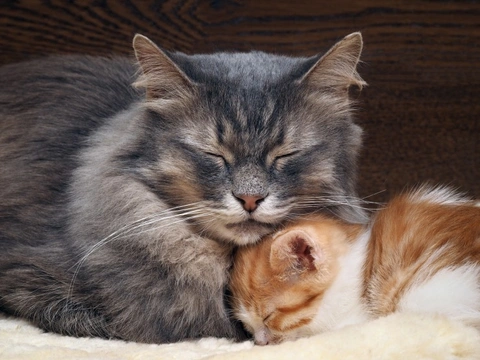
6 important life skills that mother cats teach their kittens
It used to be a common assumption that when a mother cat had successfully weaned her kittens onto solid food, the kittens could be removed from the mother and sent off to their new homes, as they didn’t need anything else from their mum. However, separating the kittens from the mother at six or eight weeks old as used to be the norm, is now considered to be much too young, as we now know the value of leaving kittens with their queen for a few weeks more.
As well as of course providing food for the kittens during their first few weeks of life, mother cats teach their young a whole host of other things as well, about how to be a cat, and how to take care of themselves and thrive when they do go out on their own. This is why today, the accepted age for kittens to leave their mother is around twelve weeks old, and generally, registered pedigree breeders will not allow their kittens to go on to their new homes before this time.
In this article, we will look at six of the most important skills that a mother cat teaches her kittens, and why these things are so important to the litter later in life. Read on to learn more!
Safety
The mother cat will show her kittens caution when faced with new situations, such as being wary around strangers, and how to approach another person, strange cat or dog carefully, in order to give themselves room to run away if the other party poses a threat! Young kittens tend to approach everyone and everything boldly until their queen shows them otherwise-this boldness can be valuable, if you are hoping to introduce the kittens to dogs at a young age, but a little caution now and then is important too!
Hunting for food
The hunting instinct is an inherent one in cats, which means that all of the kittens will be born with the basic drive and instinct to hunt for themselves. However, the mother cat will teach her kittens how to hunt successfully, where to seek out potential prey, and how to approach them and go in for the catch without scaring their target off!
You may see this manifested with toys or play between the litter and the queen, or if the mother cat goes outside when the kittens are a few weeks old, she may even bring back live prey for them to teach them what to do!
What to eat
Not only does the queen teach kittens how to hunt for themselves, but they will also show the kittens by example what is good to eat and what to steer clear of, largely leading by example. This does mean that if the queen is particularly finicky about food or dislikes a certain thing, the kittens will likely pick this up too-not because they genuinely don’t like it, necessarily, but because they have learned not to eat it from their queen!
Toileting
When the kittens are very young, their queen has to stimulate toileting in her kittens, but when they are old enough to handle their business themselves, the queen will show them how to use a litter tray, and how to take care of burying their waste to keep predators away!
Interacting with others
Kittens will learn from the other members of their litter about playing and having a good time with others, and they will also probably miss their litter mates when they go out on their own, and having another young cat around can be very rewarding for both parties-as long as they all get on!
While cats are not naturally the most sociable of animals and battles over territory can potentially get quite serious, all cats learn nonetheless about the basics of sharing space, avoiding trouble, and what constitutes appropriate behaviour so that everyone is happy!
Self-limitation
As well as learning the basics of socialisation and how to play and get on with others-or at least reach a truce over territory-the littermates and queen also teach each kitten the importance of learning to curb and moderate their behaviour as the situation warrants it.
This largely involves the use of teeth and claws in play-when the kittens are learning to hunt, play and pounce on things, they will often spend a lot of time wrestling with each other, and pouncing on each other too. However, tiny kitten teeth and claws are sharp and can hurt, and so this process helps kittens to learn to moderate their bite and scratch to avoid causing pain. This occurs both to the pained yelp response they will get from their partner when they go too far, and also from their own experience of the pain of being bitten or scratched too!



